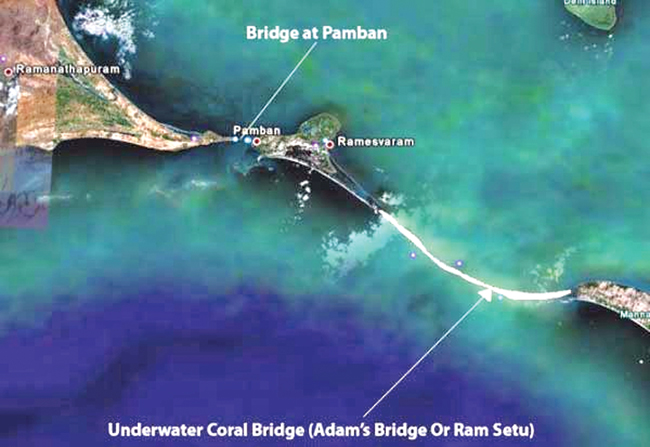NEW DELHI. Indian scientists will soon undertake a possibly first scientific expedition to date the chain of corals and sediments forming the Ram Setu, also known as Adam’s Bridge.
This 48-km long bridge-like structure between India and Sri Lanka finds mention in the great Hindu epic Ramayana, but little is known or scientifically proven about its formation.
Recently, a central advisory board on archaeology, functioning under the Archaeological Survey of India (ASI), approved the project proposal submitted by the Council for Scientific and Industrial Research and the Goa-based National Institute of Oceanography (NIO) to study the sediments and determine its origin.
The CSIR-NIO will undertake a three-year scientific project. “The idea is to see whether Ram Setu is a man-made structure or not. The most important aspect of the project is to establish its age scientifically. Once it is known, the information can be verified and co-related with its mention in the Ramayana and similar scriptures,” said Prof. Sunil Kumar Singh, director, NIO.
Carbon dating techniques, which are now available in India, will be primarily used to determine the age of the sediments.
Broadly, the explorers will apply a number of scientific techniques while attempting to date the Ram Setu, study its material composition, outline the sub-surface structure along with attempting to excavate remnants or artifacts, if any, from the site.
The project is expected to formally commence by the end of March. An initial survey will make use of underwater photographs to check if any habitation remains inundated in the area. A geophysical survey will be performed to understand the structure.
“Over the years, several kinds of depositions, including sand, have covered the actual structure. Initially, only physical observation, and no drilling, will be done. A scientific survey will be performed to understand the sub-surface structure,” said Singh.
Once this is fully understood, the scientists plan to drill into the structure, gather samples and later perform laboratory-based studies.
The NIO director added: “Some scriptures mention wooden slabs along the Setu (Hindi for Bridge). If so, they should have fossilised by now, which we will try to locate. Using high-end techniques, we will look for corals and date the gathered samples. The NIO is equipped with the latest technology. Most of the scientific analysis will be done at NIO or within laboratories in India.”
As the locality around Ram Setu is shallow, with depth not more than three to four metres beneath water, the scientists will use local boats to ferry along the Setu. This is because large vessels or ships cannot sail at such shallow depths.
Side scan SONAR will be used for bathymetry. This is similar to studying topography of a structure on land. Soundwaves signals will be sent to the structure, which will provide an outline of the physical structure of the Ram Setu.
As part of the silo seismic survey, mild earthquake-like tremor shocks will be sent at shallow depths close to the structure. These energised shockwaves are capable of penetrating into the structure. The reflected or refracted signals will be captured by instruments that will provide sub-surface structure.


